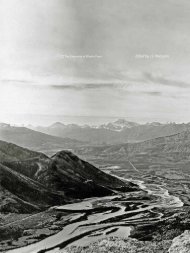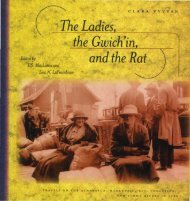Paul Kane's Journal of his Western Travels, 1846-1848 - History and ...
Paul Kane's Journal of his Western Travels, 1846-1848 - History and ...
Paul Kane's Journal of his Western Travels, 1846-1848 - History and ...
You also want an ePaper? Increase the reach of your titles
YUMPU automatically turns print PDFs into web optimized ePapers that Google loves.
still smoking after having erupted two years before) to<br />
the NisqualJy River, Puget Sound, Vancouver Isl<strong>and</strong>,<br />
<strong>and</strong> the opposite mainl<strong>and</strong>, from March 25th to June<br />
20th. Of <strong>Kane's</strong> work during t<strong>his</strong> trip, Russell Harper<br />
has written:<br />
Nearly a hundred sketches sUTVive from the three<br />
months during which Kane worked on the southern tip <strong>of</strong><br />
Vancouver Isl<strong>and</strong>. along the adjoining coasts <strong>of</strong> British<br />
Columbia <strong>and</strong> in the state <strong>of</strong> Washington. These are <strong>of</strong> the<br />
greatest ethnological <strong>and</strong> <strong>his</strong>torical interest, <strong>and</strong> some are<br />
among <strong>his</strong> finest artistic productions. 'Their subject-maner<br />
has no parallel in the work <strong>of</strong> any other 19th century artist<br />
in the same region. 3l<br />
On July 2nd, Kane made <strong>his</strong> last departure from<br />
Fort Vancouver, heading up the Columbia for the<br />
interior with the inl<strong>and</strong> brigade. He stopped for some<br />
time in the vicinity <strong>of</strong> Walla Walla. At t<strong>his</strong> point he<br />
spent five days with the Whitmans. He also sketched<br />
in the Palouse River valley (a tributary <strong>of</strong> the Snake<br />
River, in Washington) during extremely hot summer<br />
weather before returning to Walla Walla <strong>and</strong> making <strong>his</strong><br />
way upriver by canoe <strong>and</strong> overl<strong>and</strong> by horse (via the<br />
~r<strong>and</strong> Coulee) to Fort Colville (today's Colville, Washmgton).<br />
He left there on September 22nd with the last<br />
interior brigade <strong>of</strong> the season, <strong>and</strong> arrived at Boat<br />
Encampment on October 10th. After waiting three<br />
weeks for the arrival <strong>of</strong> the brigade coming from the<br />
other side <strong>of</strong> the mountains, K~e retraced the route <strong>of</strong><br />
November, <strong>1846</strong>, <strong>and</strong> reached Fort Edmonton on December<br />
5th. lbere, he enjoyed Christmas <strong>and</strong> some<br />
repose before taking two extensive trips with Fran~is<br />
Lucie, a Metis guide at Fort Edmonton: one <strong>of</strong> 200<br />
miles by cariole <strong>and</strong> dog team dowruiver to Fort Pitt<br />
(on the Alberta-Saskatchewan border) in January,<br />
<strong>1848</strong>; <strong>and</strong> another <strong>of</strong> 180 miles by horse southwest to<br />
Rocky Mountain House in April. Kane left Fort Edmonton<br />
for the last time on May 25th, <strong>and</strong> on October<br />
13, <strong>1848</strong>, he arrived in Toronto by the route that he had<br />
traveled in the other direction in the spring <strong>and</strong> summer<br />
<strong>of</strong> <strong>1846</strong>.<br />
<strong>Paul</strong> <strong>Kane's</strong> journal is published here in its original<br />
fonn with the pennission <strong>of</strong> its owner, the NeldaC. <strong>and</strong><br />
H. J. Lutcher Stark Foundation, Stark Museum <strong>of</strong> Art,<br />
Orange, Texas. The journal itself is a leatherbound<br />
memor<strong>and</strong>um book, with a brass clasp at the bottom, a<br />
pencil sheath on the right-h<strong>and</strong> side, <strong>and</strong> 72 leaves. The<br />
front <strong>and</strong> back covers are lined with green plaid paper.<br />
The journal measures .55" thick x 3.7" wide Oeft to<br />
right, as the lines <strong>of</strong> text are written) x 5.9" high (top to<br />
bottom, as the text reads). 'The text appears on n9<br />
unnumbered pages, written unless otherwise indicated,<br />
in pencil. From twenty to thirty lines <strong>of</strong> text<br />
appear on each page.<br />
Square brackets in the printed text indicate additions<br />
to <strong>Kane's</strong> own words. egible words are designated<br />
by solid lines. With a few minor exceptions<br />
the lengths <strong>of</strong> lines foUow exactly <strong>Kane's</strong> own. The<br />
text dates from May 9, <strong>1846</strong>, when Kane left Toronto,<br />
to September 13 <strong>1848</strong> (although there is nothing<br />
entered for that date), when he was still northwest <strong>of</strong><br />
Lake Superior, a month from Toronto by canoe,<br />
steamboat, <strong>and</strong> coach.<br />
<strong>Kane's</strong> round-trip journey allows for the possibility<br />
that any <strong>of</strong> the sketches was made on one <strong>of</strong> at<br />
least two occasions. Thus the dates assigned in the<br />
captions depend on the best available evidence:<br />
<strong>Kane's</strong> journal, <strong>his</strong> l<strong>and</strong>scape <strong>and</strong> portrait log other<br />
contemporary sources. Harper's study, the titles <strong>of</strong><br />
the pictures themselves. <strong>and</strong>, where reasonable.<br />
W<strong>and</strong>erings <strong>of</strong> an Artisl. Because in some cases the<br />
journal does not mention all the people <strong>and</strong> places be<br />
painted, or simply because the journal has lacunae for<br />
some portions <strong>of</strong> <strong>his</strong> itinerary, dates in some <strong>of</strong> the<br />
captions must rely on these other sources. All <strong>of</strong> the<br />
paintings done on can~as were executed following <strong>his</strong><br />
return. to Toronto in October, <strong>1848</strong>, <strong>and</strong> by 1856, when<br />
he fulfilled commitments to George W. Allan <strong>and</strong><br />
what was then the Parliament <strong>of</strong> Canada.<br />
To help the reader underst<strong>and</strong> Kane' s phonetic,<br />
variant spellin~s <strong>and</strong> to identify the many characters<br />
<strong>and</strong> places the artist encountered. two references<br />
have been provided: a Glossary <strong>of</strong> Common Words<br />
<strong>and</strong> a Guide to People <strong>and</strong> Places in Kane s <strong>Journal</strong><br />
containing detailed biographical, geographical, <strong>and</strong><br />
<strong>his</strong>torical information.<br />
1. The transcription <strong>and</strong> publication <strong>of</strong> <strong>Paul</strong> Kane' 5 journal which is<br />
has<br />
in the coUection. <strong>of</strong> the Stark Museum <strong>of</strong> M Orange T~xas ,<br />
bee~ made posSIble through the kind permission <strong>of</strong> Nelda C. Starlc.,<br />
Chauman, Nelda C. <strong>and</strong> H.J. Lutcher Stark Foundation who<br />
provided convenient <strong>and</strong> mOSl hospitable access to the ~t·<br />
Anna Jean Caffey, Registrar oCthe Stark Museum <strong>of</strong> Art ~ <strong>and</strong> ~<br />
Bowler, also <strong>of</strong> the Stark Musewo.<br />
2. Bison is the COlTect term, but buffalo, because Kane uses the<br />
word exclusively, will be kept here.<br />
3. Saulteaux is a name given to the westernmost part <strong>of</strong> the Chip--<br />
20<br />
pewa/Ojibwa nation from the falls <strong>of</strong> Sault Sainte Marie both<br />
shores <strong>of</strong> Lake Superior <strong>and</strong> weU into the northern interior,' as far<br />
west as the Turtle Mountains in what is now North Dakota <strong>and</strong> as<br />
far north as the eastern shore <strong>of</strong> Lake Winnipeg.<br />
4. The nickname is a conundrum. Judging by the fact that Kane<br />
speUs t.he name Francois as "Frans way ," Bushway is likely the<br />
phonetiC fonn <strong>of</strong> a French word such as boucher or bouchee. 'There<br />
IS no French word bouchois. TIle possibilities for translation stem<br />
from two words: boucher <strong>and</strong> bucher. 1be latter is a verb meaning<br />
to work or to study with fury <strong>and</strong> ardor. Perhaps the name then<br />
MacLaren! Kane
















